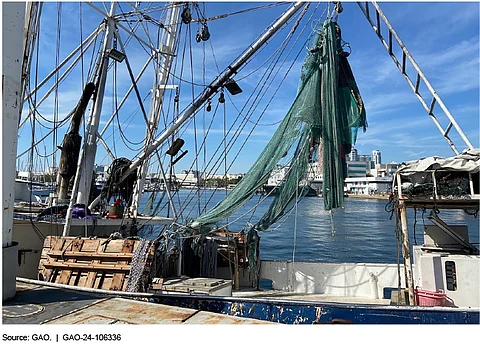

Shrimp Trawler in the Gulf of Mexico. According to the GAO, only 2% of trips in the Gulf of Mexico shrimp trawl fishery have observers, leading to less reliable bycatch data.
Photo: GAO.
The US Government Accountability Office (GAO) has issued a report urging the United States National Marine Fisheries Service (NMFS) to enhance its tracking and communication efforts related to the reduction and monitoring of bycatch.
Bycatch, which refers to marine life unintentionally caught or harmed during fishing activities, remains a significant concern for the sustainability of fishing communities and ocean ecosystems.
The GAO points out that, under the US Magnuson-Stevens Fishery Conservation and Management Act, NMFS and the regional fisheries management councils are required to "develop conservation and management measures that, among other things, aim to minimize bycatch and bycatch mortality 'to the extent practicable'".
The GAO report addresses measures used to reduce bycatch, coverage and funding of fisheries observers, how bycatch estimates are developed and reported, and how NMFS tracks its performance towards reducing and monitoring bycatch.
In addition to drawing on relevant legal and policy documents, the GAO study also undertook interviews with NMFS and council officials and relevant stakeholders, including representatives from the fishing industry and academia. GAO selected five fisheries for a more in-depth review, reflecting a range of geographic regions, fishing gear types, and key bycatch concerns.
In particular, the report highlights inconsistencies in the deployment of fisheries observers, who collect critical data on bycatch. Observer coverage varies widely, from zero to 100 percent of fishing trips, depending on the fishery, the GAO found.
For example, only 2 percent of trips in the Gulf of Mexico shrimp trawl fishery have observers, leading to less reliable bycatch data. Limited funding for observer programs and difficulties in recruiting and retaining observers contribute to this problem, the GAO says.
Creating bycatch estimates involves extrapolating data from observed trips to entire fisheries, the GAO notes. However, this process is more challenging and less reliable for fisheries with fewer observers.
The GAO study points out that the NMFS and Regional Fishery Management Councils rely on these estimates to make informed management decisions, but despite this, NMFS has not consistently communicated the resource needs for observer programs to Congress and other stakeholders, the report found.
To address these issues, the GAO has made four recommendations, which NMFS has agreed to implement:
Communicate Resource Needs: Gather and communicate information on additional resources required to support fisheries observers to stakeholders, including Congress.
Update Bycatch Reduction Plan: Develop an updated National Bycatch Reduction Strategy Implementation Plan with measurable performance goals.
Track Progress: Establish a process to track progress towards these performance goals and use the information to guide decision-making.
Develop Reporting Plan: Create a comprehensive plan for reporting on bycatch estimates from the enhanced Fisheries One Stop Shop database, including communication on bycatch levels, trends, and information gaps.
